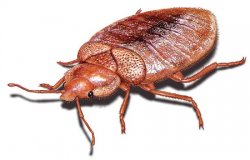Bed Bugs
 The two species of bed bugs (Insecta: Hemiptera: Cimicidae) usually implicated in human infestations are Cimex lectularius and C. hemipterus. Although rare, humans may become incidental hosts of Cimex species of bats and birds.
The two species of bed bugs (Insecta: Hemiptera: Cimicidae) usually implicated in human infestations are Cimex lectularius and C. hemipterus. Although rare, humans may become incidental hosts of Cimex species of bats and birds.
Adults and all nymphal stages of Cimex spp. need to take blood meals from warm-blooded hosts, which are typically humans for C. lectularius and C. hemipterus, although other mammals and birds can be utilized in the absence of a human host. Female bed bugs lay about five eggs daily throughout their adult lives in a sheltered location (mattress seams, crevices in box springs, spaces under baseboards, etc). Eggs hatch in about 4-12 days into first instar nymphs which must take a blood meal before molting to the next stage. The bugs will undergo five nymphal stages each one requiring a blood meal before molting to the next stage, with the fifth stage molting into an adult. Nymphs, although lacking wing buds, resemble smaller versions of the adults. Nymphs and adults take about 5-10 minutes to obtain a full blood meal. The adults may take several blood meals over several weeks, assuming a warm-blooded host is available. Mating occurs off the host and involves a unique form of copulation called ‘traumatic insemination’ whereby the male penetrates the female’s abdominal wall with his external genitalia and inseminates into her body cavity. Adults live 6-12 months and may survive for long periods of time without feeding.
General Bed Bug Info
Bedbugs are small oval insects that feed by sucking blood from humans or animals.
Bedbugs can live anywhere in the home or office, etc. They can live in cracks in furniture or in any type of textile. They are most common in beds (mattress, box springs, and bed frames) and furniture.
Bedbugs are most active at night. Bedbugs may bite any exposed areas of skin while an individual is sleeping. Common locations for bedbug bites are the face, neck, hands, and arms.
A bedbug bite is painless and is generally not noticed. The bites may be mistaken for a rash of another cause. Small, flat, or raised bumps on the skin are the most common sign. Symptoms include redness, swelling, and itching.
Typically, no treatment is required for bedbug bites. If itching is severe, steroid creams or oral antihistamines may be used for symptom relief.
Fecal stains, egg cases, and shed skins (exuviae) of bedbugs in cracks and crevices on or near beds and furniture are suggestive that bedbugs may be present.
